Category: Environment
Gov. Inslee’s Wastewater Plant Tour Highlights Sea Rise Woes
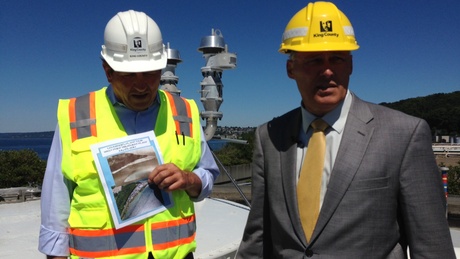
By: Ashley Ahearn, KUOW
SEATTLE — When Washington Gov. Jay Inslee wanted to show the connection between climate change and an unpleasant and costly consequence for his constituents, he decided to tour a sewage treatment plant.
Inslee’s visit Tuesday to the West Point Wastewater Treatment Plant in Seattle’s Discovery Park was the latest stop on his statewide tour to raise awareness about the costs of climate change.
The problem the governor wanted to highlight: climate change is causing sea levels to rise. And that means homes and buildings that were built a safe distance from the water’s edge are increasingly becoming too close for comfort.
That message was also delivered by the White House Tuesday, when it issued a report that said global sea levels are currently rising at more than an inch per decade — and the rate appears to be increasing.
No one complained about the smell as treatment plant workers and managers led Inslee and other visitors through the facility. But there was a lot of talk about the problems with rising sea level.
Dan Grenet, the manager of the facility, showed Inslee some photographs hanging in the lobby. Waves crash over a cement wall.
“This is a photograph of Puget Sound coming into our facility – causes big problems in our pumps and piping systems and also, it’s a biological process here,” Grenet told the governor. “It doesn’t do well with salt water. Causes big problems.”
Saltwater intrusion could cost King and other shoreline counties tens of millions of dollars in infrastructure upgrades.
But during this visit, as with other stops on his climate change tour, the governor emphasized that the costs of climate change will hit from all directions.
“We’ve had $50 million in costs for fighting fires. Tens of millions of dollars of damage to the oyster industry,” Inslee said. “And here we don’t have an estimate at West Point but we know it’s significant because we know it’s not just this point its all these ancillary pumping stations that are going to have to be if not rebuilt, refortified to deal with sea water intrusion.”
Inslee’s latest task force on climate change has been charged with developing a plan to put a price on CO2 emissions. The plan is expected be presented to the state Legislature this fall.
NEAR LA CONNER: Swinomish tribe, State Parks open preserve
Staff report: June 29, 2014
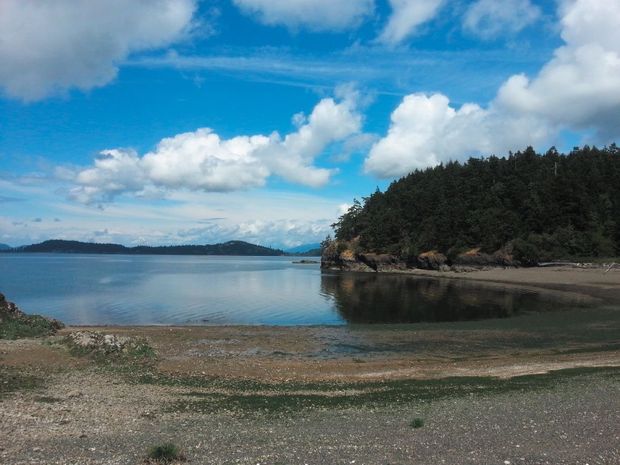
Photo: WASHINGTON STATE PARKS
The Kukutali Preserve in Similk Bay near La Conner has opened through a partnership between Washington State Parks and the Swinomish Indian Tribal Community.
The preserve opened to the public during a ceremony June 16.
State and tribal officials said the preserve is believed to be the first park in the United States to be co-owned and co-managed by a tribe and another government, such as a state. Management of the preserve will focus on conservation and research, public education and limited recreational use, according to a State Parks news release.
“It’s a great day to be making history,” Swinomish tribal Chairman Brian Cladoosby said during his keynote address at the opening ceremony.
“It’s going to be great for visitors to witness and see the beauty that we’ve seen here forever,” Cladoosby said in the release. “This wouldn’t have been possible without a lot of people coming together to make sure this dream became a reality.”
Located entirely within the Swinomish Reservation, the preserve includes 84 upland acres on Kiket Island and Flagstaff Point and 9 upland acres on Fidalgo Island. It includes more than 2 miles of nearly intact shoreline, with native eelgrass beds, multiple fish species and shellfish.
Numerous endangered or threatened species make their home in the preserve’s diverse habitats, which include old-growth trees.
Among the preserve’s unique features is a rare type of environment called a “rocky bald,” according to State Park officials. Found on Flagstaff Point, west of Kiket Island, this area has fragile, thin soil that hosts a unique community of native plants and nesting waterfowl. To protect that ecosystem, access to Flagstaff Point is prohibited.
The preserve also contains cultural resources important to the Swinomish tribe.
Right now, there are 2 miles of walking trails with plans to add an ADA-accessible boardwalk, another trail and amenities such as a picnic shelter, picnic sites, interpretive information and two vault restrooms, according to the release.
The preserve is open daily for day use only, from dawn to dusk. Vehicles will be limited to the parking lot, and the remainder of the site is accessible only by foot. The parking lot is at the northwest corner of Snee-Oosh and Kiket Island roads, west of La Conner. A Discover Pass is required to park at the preserve
State Parks, with the help of the Trust for Public Land, acquired the upland portion of the property in June 2010 after it had been owned privately for almost 100 years.
Learn more
More information and background on the Kukutali Preserve management and master plan available at parks.wa.gov/299/Kukutali-Preserve.
Bizarre News About the Bee Czar
Last year, there was an emergency around a public housing project in the medium-sized suburb of Austin, Texas, where I reside. A swarm of honeybees had ensconced itself in a tool shed and the residents, mostly elders, were scared. One had an allergy to bee stings, and so for him a mishap could be fatal.
The Fire Department was called, Animal Control was called, and eventually the bees were dispatched with insecticide. Lots of people questioned that action at the time. Time had published a cover story back in 2013 warning that nearly one third of US honeybee colonies had died or disappeared since Colony Collapse Disorder (CCD) broke out in 2004. Most people who pay attention to the news have by now heard of CCD, even though the causes of it are still hotly departed.
More is at stake here than tradition, but indigenous peoples have plenty of tradition on the line. The Spanish entrada led by Hernando De Soto recorded finding honey in a Cherokee village in 1540. There is an old Cherokee tale about how Bee got a stinger that involves humans trying to steal so much honey that the bees did not have enough left to subsist.
RELATED: The Origins of Golden Honey and its Gastronomic and Medicinal Uses
With the coming of CCD, farmers have been threatened with loss of bees to pollinate a long list of crops that human beings enjoy consuming and the price of renting bees for pollination of crops has skyrocketed. When the bees started to die off in 2004, California almond growers paid about $45-$54 for the one colony per acre they needed. The prices spiked sharply, going well over copy50 before easing back to remain at that approximate level. Most fruits and vegetables do not require as much time for the bees to do their work, so the prices are accordingly lower, but still higher than farmers were used to paying before CCD.
Pollination of food crops by bees is necessary to humans, but ever since Bee got a stinger, most humans are a little bit afraid our buzzing buddies. A feral swarm is seen as a threat and the common remedy is insecticide.
A nonprofit organization has gotten started in Central Texas with a solution that could travel to other locations. The American Honey Bee Protection Agency & Central Texas Bee Rescue has taken on the protection of feral bees. The nonprofit survives with donations, with taking in small fees for bee removal, and, of course, with sales of honey. If somebody feels threatened by a swarm and cannot afford the fee, they are asked to pay what they can afford, but the bees are “rescued.”
This organization is the brainchild of a beekeeper named Walter Schumacher, who is currently employed by Prairie View A&M University to develop a master bee-handling course. Schumacher calls himself the “Bee Czar.” The Bee Czar has found one colony a home on top of the luxurious W Hotel in downtown Austin, where the bees pollinate the rooftop garden and the hotel uses the honey in their restaurant and in spa treatments.
Local grocery stores carry wild honey harvested from feral bees as well as honey sold under the Honey Co-op brand, produced by cooperating apiaries that split the profits with the bee rescue group. Products made of beeswax will be forthcoming.
Central Texas Bee Rescue has created a model for a self-funding non-profit organization dedicated to seeing that bees scaring humans with their natural swarming behavior will not receive an automatic death sentence. The bees will, instead, help pay for their own preservation. Preserving the bees preserves many fruits and vegetables humans depend on, so Bee of Cherokee lore would be proud that we finally learned to live together.
Read more at http://indiancountrytodaymedianetwork.com/2014/07/29/bizarre-news-about-bee-czar-156105
M’ville mayor wants to bridge gap if coal trains come through town
By: Steve Powell, Arlington Times
MARYSVILLE — Mayor Jon Nehring has a love-hate relationship with the proposal for a new coal terminal in Cherry Point.
This doc about “bomb trains” filled with crude oil will make your head explode
By Ted Alvarez, Grist
VICE News just released Bomb Trains: The Crude Gamble of Oil by Rail, a 23-minute-long documentary investigating the explosive oil trains that regularly run from the Bakken shale to the Pacific Northwest. That might seem a bit long for web video, but you should watch it anyway — mostly because Thomas the Terror Engine is headed to your town, but also because Jerry Bruckheimer has nothing on the terrifying explosions at the 5:09 and 6:00 marks.
Oh, and you can find out if you live near a bomb-train blast zone right here. (Spoiler alert: You probably do.)
Sea Star Disease Strikes Washington Marine Centers
July 28, 2014 | AP
PORT ANGELES, Wash. (AP) — The disease wreaking havoc on wild sea star populations on the West Coast has struck captive collections on Washington’s Olympic Peninsula.
The Peninsula Daily News reports Monday that sea stars at Port Townsend’s Marine Life Center and Feiro Marine Life Center in Port Angeles have died of the disease, known as sea star wasting.
In Port Townsend, 12 ochre stars have died, while the illness eliminated a species from the tanks in Port Angeles. Both centers pipe in ocean water for their tanks. Experts believe the disease is infectious and might be caused by bacteria or a virus.
Caretakers at the Olympic Peninsula’s marine science centers don’t intend to replace sea stars until they feel more confident they can keep them alive. They also want to avoid taking breeding adults that might be needed to replenish wild colonies.
National Park Service Awards Historic Preservation Grants to Indian Tribes, Alaska Natives, and Native Hawaiian Organizations
Drought Starting To Kill Salmon In Klamath Basin

By: Associated Press
Low warm water conditions from the drought are starting to kill salmon in northern California and southern Oregon’s Klamath Basin — the site of a massive fish kill in 2002.
Sara Borok of the California Department of Fish and Wildlife said a survey of the Salmon River on Wednesday found 55 dead adult salmon and more dead juveniles than would be expected this time of year. The reason is low and warm water related to the drought.
Fisheries officials do not want see a repeat of 2002, but there is little to do but pray for rain. Even in the Klamath River, which has dams to store water, there is little available for extra releases.
The Salmon River is a tributary of the Klamath River.
Amazon oil spill has killed tons of fish, sickened native people
CUNINICO, Peru – On the last day of June, Roger Mangía Vega watched an oil slick and a mass of dead fish float past this tiny Kukama Indian community and into the Marañón River, a major tributary of the Amazon.
Community leaders called the emergency number for Petroperu, the state-run operator of the 845-kilometer pipeline that pumps crude oil from the Amazon over the Andes Mountains to a port on Peru’s northern coast.
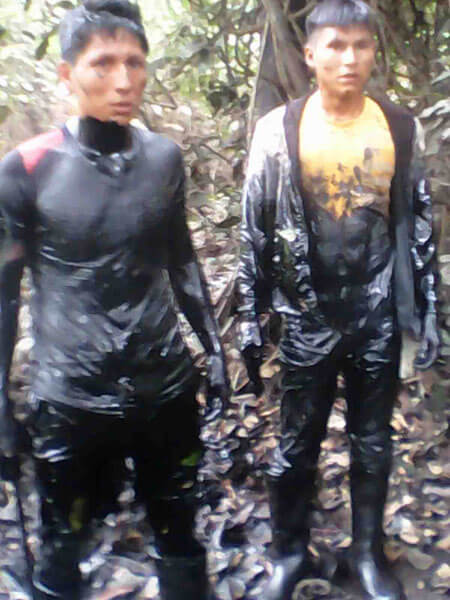
Local men were covered with oil after being hired to find the leak in the submerged pipeline. (Photo: Municipality of Urarinas)
By late afternoon, Mangía and a handful of his neighbors – contracted by the company and wearing only ordinary clothing – were up to their necks in oily water, searching for a leak in the pipe. Villagers, who depend on fish for subsistence and income, estimated that they had seen between two and seven tons of dead fish floating in lagoons and littering the landscape.
“It was the most horrible thing I’ve seen in my life – the amount of oil, the huge number of dead fish and my Kukama brothers working without the necessary protection,” said Ander Ordóñez Mozombite, an environmental monitor for an indigenous community group called Acodecospat who visited the site a few days later.
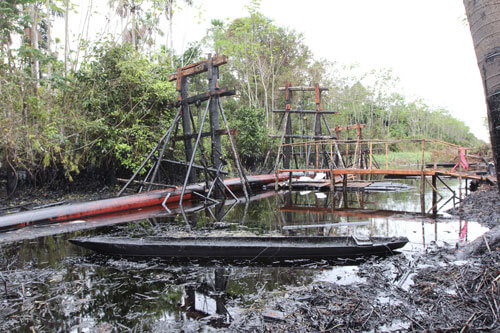
Scaffolding holds a broken section of the oil pipeline. (Photo: Barbara Fraser)
This rupture of Peru’s 39-year-old northern crude oil pipeline has terrified Kukama villagers along the Marañón River. People’s complaints of nausea and skin rashes are aggravated by nervousness about eating the fish, concerns about their lost income and fears that oil will spread throughout the tropical forest and lakes when seasonal flooding begins in November. Cuninico, a village of wooden, stilt-raised, palm-thatched houses, is home to about 130 families but several hundred families in other communities also fish nearby.
Three weeks after they discovered the spill, the villagers still have more questions than answers about the impacts.
“It sounds like an environmental debacle for the people and the ecosystem,” said David Abramson, deputy director of the National Center of Disaster Preparedness at Columbia University’s Earth Institute in New York.
“There is a need for public health and environmental monitoring at a minimum of four levels – water, fish, vegetation and the population,” he said.
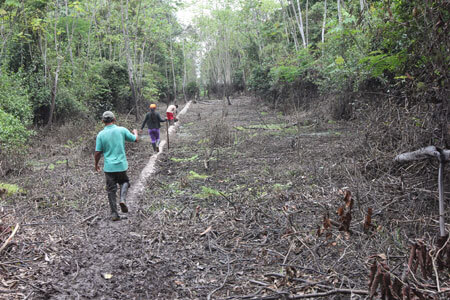
Kukama community leaders walk along the pipeline through a marshy area. (Photo: Barbara Fraser)
Company officials at Petroperu did not return phone calls and emails seeking comment.
Government officials have not officially announced how much crude oil spilled. However, in a radio interview, Energy and Mines Minister Eleodoro Mayorga mentioned 2,000 barrels, which is 84,000 gallons.
Indigenous leaders noted that the pipeline, which began operating again July 12 after the repairs, has a history of leaks.
Leaders of at least four neighboring communities said masses of dead fish appeared in lagoons and streams in the week before the oil spill was reported, indicating that it could have been leaking for days before it was spotted.
Even fish that escaped the worst of the spill could be poisoned, experts said. Fishermen who traveled an hour or two up the Urituyacu River, a tributary of the Marañón, in search of a catch unaffected by the spill returned with fish that they said tasted of oil.
Some Amazonian fish migrate long distances, and ongoing monitoring will be important for determining how fisheries recover, said Diana Papoulias, a fish biologist with E-Tech International, a New Mexico-based engineering firm that advises indigenous Peruvian communities on oil-related issues.
Key concerns include polycyclic aromatic hydrocarbons (PAHs), which are classified as probable human carcinogens and can cause skin, liver and immune system problems, according to the U.S. Centers for Disease Control and Prevention. Exposure to PAHs in the womb has been linked to effects on children’s brain development, including learning and behavioral changes.
“The rule of thumb is that during the spill it’s a horrible mess, and two or three years later it’s hard to find evidence.” –Edward Overton, Louisiana State University For pregnant women, the fish become a “double-edged sword,” Abramson said. “They need that protein source to enhance the neurological development of the fetus, but at the same time, you don’t want them ingesting things that have unknown impacts.”
Mothers said children and adults in their families are suffering from stomachaches, nausea, vomiting and dizziness, and small children have skin rashes after bathing in the rivers.
In this part of the Marañón valley, the nearest health center is more than an hour away by boat and does not have a doctor.
The government’s Environmental Evaluation and Oversight Agency (Organismo de Evaluación y Fiscalización Ambiental, OEFA) has taken no samples of fish tissue for testing, according to Delia Morales, the agency’s assistant director of inspection.
Much of the oil settled in pools along the pipeline during the flood season, creating a viscous soup where dying fish flopped weakly. Government officials said damage was limited to a 700-meter stretch along the pipeline. The ground and tree trunks in the forest on both sides of the pipeline were also stained with oil, in a swath local residents estimated at up to 300 meters wide. When that area begins to flood again in November, villagers fear that contamination could spread.

Kukama women wash clothes in the river that also provides water for drinking, cooking and bathing. (Photo: Radio Ucamara)
Petroperu hired men from the village of Cuninico to find the leak and raise the pipeline out of the canal to repair it. Several of the men said they were up to their necks in oily water, working in T-shirts and pants or stripped to their underwear. They said they received protective gear only when a Peruvian TV crew arrived more than two weeks later. The July 20 newscast led to a shakeup in Petroperu’s leadership.
Meanwhile, the workers’ wives wash their clothes in the Marañón River, squatting on rafts moored along the bank. Besides being the only transportation route in the area, the river is the source of water for drinking, cooking, bathing and washing.
Within a week after the spill, the local fish market had dried up. Women who normally sold 10 to 20 kilos of fish a day said their usual buyers shunned them. Children in Cuninico told a reporter from Radio Ucamara, a local radio station, that fish had disappeared from the family table and they were eating mainly rice and cassava, a root.
Abramson said the villagers’ mental health can be undermined by poor diet, income loss and conflicts between community members.
The pipeline has been repaired and the oil is flowing to the port again, but the long-term impacts of the spill are uncertain.
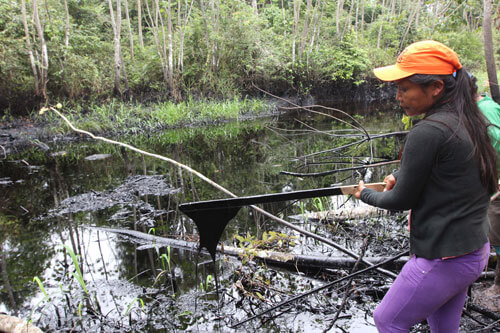
Glob of oil drips from a stick dipped into a pool beside the submerged pipeline. (Photo: Barbara Fraser)
Light and bacteria help break down oil naturally, said Edward Overton, a chemistry professor in Louisiana State University’s Department of Environmental Studies who has studied the Deepwater Horizon oil spill in the Gulf of Mexico. Volatile substances in the oil, which dissolve readily in water, could have caused the fish kills if the pipeline had been leaking for a time before the spill was reported, he said.
“The rule of thumb is that during the spill it’s a horrible mess, and two or three years later it’s hard to find evidence,” Overton said.
But that may not be the case in Amazonian wetlands, where clay soil and high water limit the oxygen available to oil-eating microbes, said Ricardo Segovia, a hydrogeologist with E-Tech International.
The government’s environmental agency is expected to issue its report on the spill by the end of this month and could levy fines, Morales said.
Villagers are waiting to see whether the government will sanction its own pipeline operation and pay damages.
“It sounds as though the state is in a precarious position,” Abramson said. “It [the government of Peru] has to monitor and assure the health and well-being of the population, but it may be one of the agents that is liable [for the spill]. They have to monitor themselves and decide what is fair and equitable.”








